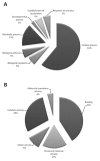Transcriptome analysis of Taenia solium cysticerci using Open Reading Frame ESTs (ORESTES)
- PMID: 19646239
- PMCID: PMC2731055
- DOI: 10.1186/1756-3305-2-35
Transcriptome analysis of Taenia solium cysticerci using Open Reading Frame ESTs (ORESTES)
Abstract
Background: Human infection by the pork tapeworm Taenia solium affects more than 50 million people worldwide, particularly in underdeveloped and developing countries. Cysticercosis which arises from larval encystation can be life threatening and difficult to treat. Here, we investigate for the first time the transcriptome of the clinically relevant cysticerci larval form.
Results: Using Expressed Sequence Tags (ESTs) produced by the ORESTES method, a total of 1,520 high quality ESTs were generated from 20 ORESTES cDNA mini-libraries and its analysis revealed fragments of genes with promising applications including 51 ESTs matching antigens previously described in other species, as well as 113 sequences representing proteins with potential extracellular localization, with obvious applications for immune-diagnosis or vaccine development.
Conclusion: The set of sequences described here will contribute to deciphering the expression profile of this important parasite and will be informative for the genome assembly and annotation, as well as for studies of intra- and inter-specific sequence variability. Genes of interest for developing new diagnostic and therapeutic tools are described and discussed.
Figures


Similar articles
-
The use of Open Reading frame ESTs (ORESTES) for analysis of the honey bee transcriptome.BMC Genomics. 2004 Nov 3;5:84. doi: 10.1186/1471-2164-5-84. BMC Genomics. 2004. PMID: 15527499 Free PMC article.
-
The contribution of 700,000 ORF sequence tags to the definition of the human transcriptome.Proc Natl Acad Sci U S A. 2001 Oct 9;98(21):12103-8. doi: 10.1073/pnas.201182798. Proc Natl Acad Sci U S A. 2001. PMID: 11593022 Free PMC article.
-
Steroid hormone production by parasites: the case of Taenia crassiceps and Taenia solium cysticerci.J Steroid Biochem Mol Biol. 2003 Jun;85(2-5):221-5. doi: 10.1016/s0960-0760(03)00233-4. J Steroid Biochem Mol Biol. 2003. PMID: 12943707 Review.
-
The genome project of Taenia solium.Parasitol Int. 2006;55 Suppl:S127-30. doi: 10.1016/j.parint.2005.11.020. Epub 2005 Dec 6. Parasitol Int. 2006. PMID: 16337432 Review.
-
Zoonotic Taenia infections with focus on cysticercosis due to Taenia solium in swine and humans.Res Vet Sci. 2021 Jan;134:69-77. doi: 10.1016/j.rvsc.2020.11.015. Epub 2020 Nov 22. Res Vet Sci. 2021. PMID: 33321377 Review.
Cited by
-
A Role for Epitope Networking in Immunomodulation by Helminths.Front Immunol. 2018 Jul 31;9:1763. doi: 10.3389/fimmu.2018.01763. eCollection 2018. Front Immunol. 2018. PMID: 30108588 Free PMC article.
-
A gel-free proteomic analysis of Taenia solium and Taenia crassiceps cysticerci vesicular extracts.Parasitol Res. 2018 Dec;117(12):3781-3790. doi: 10.1007/s00436-018-6080-7. Epub 2018 Sep 13. Parasitol Res. 2018. PMID: 30215138
-
Molecular Cloning of a cDNA Encoding for Taenia solium TATA-Box Binding Protein 1 (TsTBP1) and Study of Its Interactions with the TATA-Box of Actin 5 and Typical 2-Cys Peroxiredoxin Genes.PLoS One. 2015 Nov 3;10(11):e0141818. doi: 10.1371/journal.pone.0141818. eCollection 2015. PLoS One. 2015. PMID: 26529408 Free PMC article.
-
Proteomic study of activated Taenia solium oncospheres.Mol Biochem Parasitol. 2010 May;171(1):32-9. doi: 10.1016/j.molbiopara.2010.01.004. Epub 2010 Feb 6. Mol Biochem Parasitol. 2010. PMID: 20144663 Free PMC article.
-
A transcriptomic analysis of Echinococcus granulosus larval stages: implications for parasite biology and host adaptation.PLoS Negl Trop Dis. 2012;6(11):e1897. doi: 10.1371/journal.pntd.0001897. Epub 2012 Nov 29. PLoS Negl Trop Dis. 2012. PMID: 23209850 Free PMC article.
References
-
- Aguilar-Diaz H, Bobes RJ, Carrero JC, Camacho-Carranza R, Cervantes C, Cevallos MA, Davila G, Rodriguez-Dorantes M, Escobedo G, Fernandez JL, Fragoso G, Gaytan P, Garciarubio A, Gonzalez VM, Gonzalez L, Jose MV, Jimenez L, Laclette JP, Landa A, Larralde C, Morales-Montor J, Morett E, Ostoa-Saloma P, Sciutto E, Santamaria RI, Soberon X, De La Torre P, Valdes V, Yanez J. The genome project of Taenia solium. Parasitol Int. 2006;55:S127–130. - PubMed
-
- Sciutto E, Fragoso G, Fleury A, Laclette JP, Sotelo J, Aluja A, Vargas L, Larralde C. Taenia solium disease in humans and pigs: an ancient parasitosis disease rooted in developing countries and emerging as a major health problem of global dimensions. Microbes Infect. 2000;2:1875–1890. - PubMed
-
- Campbell G, Garcia HH, Nakao M, Ito A, Craig PS. Genetic variation in Taenia solium. Parasitol Int. 2006;55:S121–126. - PubMed
-
- Ito A, Nakao M, Wandra T. Human Taeniasis and cysticercosis in Asia. Lancet. 2003;362:1918–1920. - PubMed
LinkOut - more resources
Full Text Sources

